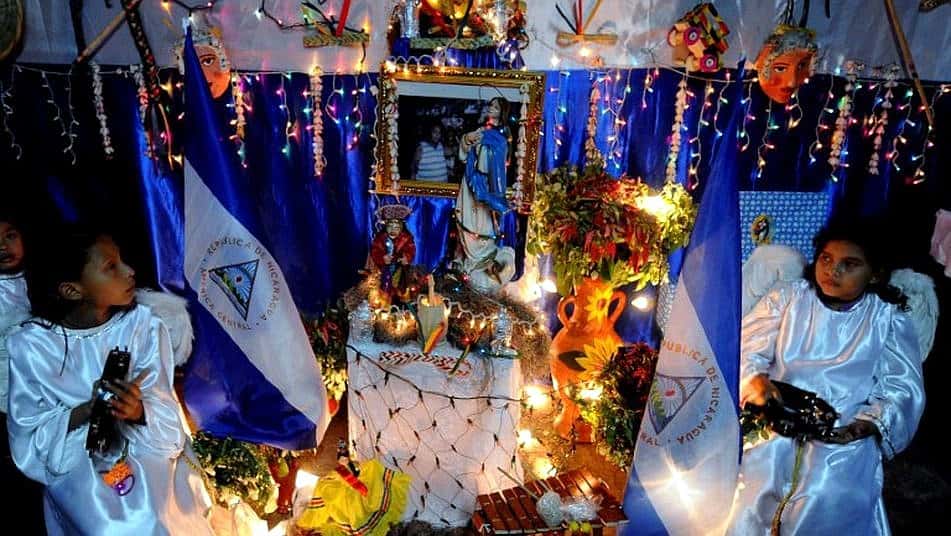Every December 7th, Nicaragua is illuminated by the vibrant tradition of La Gritería, creating a tapestry of faith, culture, and solidarity. This celebration, deeply rooted in the country’s history, continues to evolve without losing its essence, symbolizing the unity and hope that characterizes the Nicaraguan spirit.
Deep Roots: The Birth and Evolution of a Matchless Tradition
La Gritería is steeped in the history and spirituality of Nicaragua, tracing back over four centuries and marking a pivotal moment in the country’s religious tradition.
Believed to have started in 1857 in León—though Granada also claims part of this heritage—the truth is that this celebration has flourished in every corner of Nicaragua, becoming an unparalleled event of Marian fervor.
The Franciscan friars, arriving in the 13th century, were instrumental in evangelization and spreading devotion to Mary. Their influence planted the seeds of what we know today as La Gritería.
Over the centuries, especially in the 18th century, cities like El Viejo, León, and Granada became bastions of Marian faith, strengthening and spreading the celebration nationwide.
The heart of this tradition beats with the history of a people who have kept their faith and devotion alive through generations. La Gritería is a time to remember the dogma of the Immaculate Conception and reaffirm the bonds of community and solidarity among Nicaraguans.
Amid Songs and Altars: The Night Nicaragua Vibrates as One
On the night of December 7th, Nicaragua transforms into a stage of collective jubilation. Thousands of people, both locals and visitors, take to the streets in unison, participating in an act of faith and tradition passed down through generations.
The question “Who causes so much joy?” echoes through the air, followed by the unanimous and fervent response: “The Conception of Mary!” This exchange symbolizes not only a religious tradition but also the spirit of community and joy that defines Nicaraguan society.
Building altars in honor of the Virgin Mary is a central practice of La Gritería. Each family prepares their altar with devotion, decorating it with lights, flowers, and Marian symbols, creating a tangible link to the divine.
The night is filled with songs dedicated to the Immaculate Conception, as participants share toasts and gifts. From traditional foods to more modern presents, these acts of generosity reflect the essence of the celebration: sharing and gratitude.
Beyond Nicaragua’s borders, La Gritería is also present. Nicaraguans around the world gather on December 7th to keep their tradition alive, showing that distance is no obstacle to faith or cultural identity.
This extension of the celebration underscores the importance of La Gritería as a unifying element of the Nicaraguan diaspora, solidifying bonds of solidarity and belonging despite the distance.
More Than a Party: La Gritería as a Symbol of Unity and Hope
La Gritería is more than just a festivity; it’s an echo that resonates in the identity and spirit of Nicaragua. This tradition, lighting up the streets every December 7th, reflects the depth of the people’s Marian faith and fervor but also underscores the importance of community, solidarity, and shared joy.
By bringing together people of all ages and backgrounds, La Gritería transcends religion to become a living expression of culture and social cohesion in Nicaragua.
Through the centuries, La Gritería has evolved, adapting to societal changes while holding firm to its core. This ability to renew without losing its essence ensures its enduring significance and generational relevance.
Furthermore, its celebration beyond national borders highlights how culture and faith can serve as pillars of unity and recognition for the diaspora.
Nicaragua, with its rich history and traditions, showcases through La Gritería that cultural and spiritual roots remain fundamental to understanding its present and building its future.
This celebration is a reminder that in unity, faith, and tradition lies the true strength of a nation. La Gritería is not just a festivity; it’s a testament to Nicaraguan identity, a legacy renewed each year, ensuring its transmission to new generations as an invaluable treasure of joy, faith, and community.





